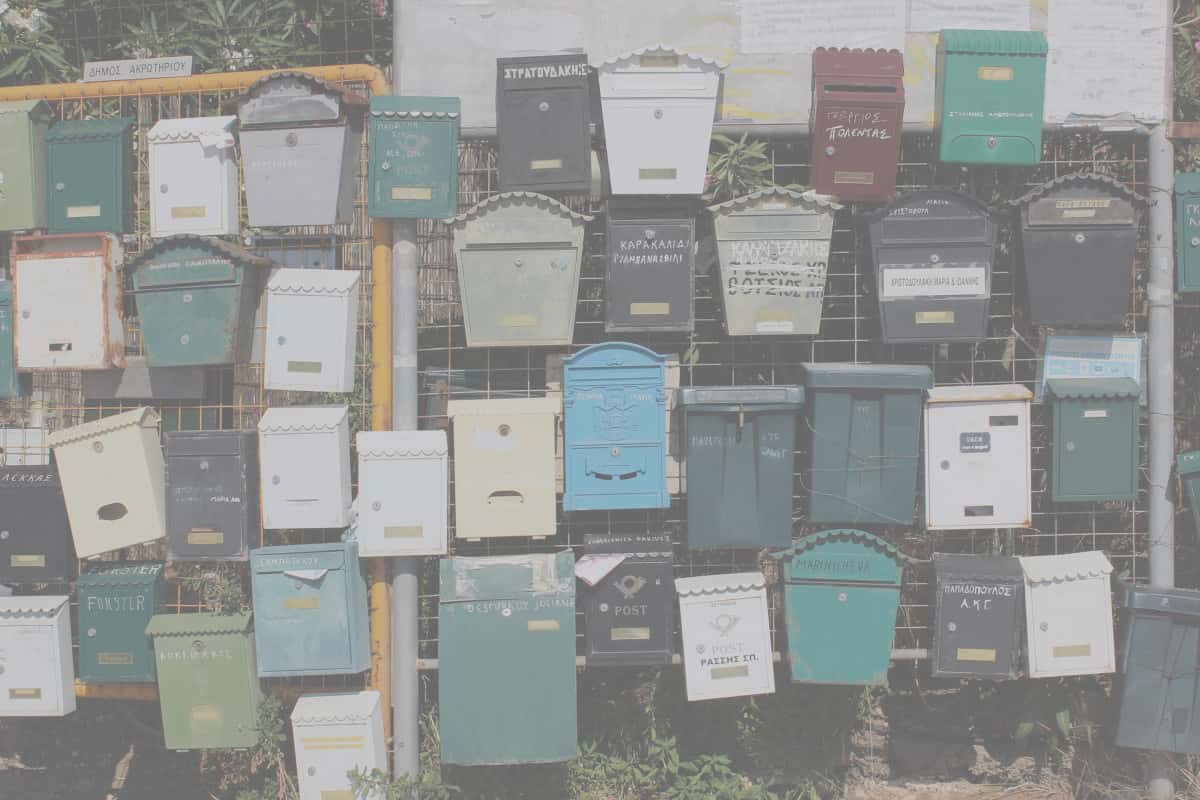Of all the gripes, trials and tribulations of the stressed and overworked modern executive, possibly the loudest complaint is the sheer volume of email one receives in a typical working day.
This is especially the case in large, multinational corporations with colleagues working on projects across multiple sites and countries.
Just consider how many contacts you may have in different parts of the business, together with the number of vendors or customers one may either directly or indirectly be responsible for.
That’s not to mention all of the non-urgent or irrelevant messages which fill up your inbox due to the ease which someone can copy others in on an email.
For all its obvious benefits it has brought to the workplace, email is also without doubt a productivity killer. It’s the number 1 time-grabbing distraction which eats into our working day and robs us of the hours we need to do more important stuff.
But it needn’t be.
It’s all about setting boundaries, being disciplined in your approach to email and being self-aware.
Indeed, you may actually be a significant part of the problem.
We’ll get into that a little bit later. First of all, the basics.
Too many emails = your day is dictated by someone else’s agenda
The primary concept you should grasp is that pretty much all emails are sent by folks asking you to spend time solving a burning issue of theirs or answering a query that is part of their agenda.
Rarely is your inbox full of tasks that are directly aligned to what you should be doing to achieve your individual objectives. So, why do we allow ourselves to be habitually distracted by the constant noise of whatever pops into our email inbox?
Clearly, our working day obviously dictates that sometimes we need to deal with stuff that helps other people. That’s part of teamwork and a collaborative work environment.
The difference is that you should deal with email on your terms, and when it’s convenient to you, if you want to increase your productivity and effectiveness.
Tip 1: Separate Direct Mail from CC Mail
Not all emails are of equal importance!
Let’s acknowledge this by mirroring this fact this in our email inboxes!
To do this, set up a rule to automatically move incoming email which is not directly addressed to you straight into a new, separate folder for CC Mail.
That’s probably between a third and a half of your email which will then automatically be tagged as “less important”.
Why is it less important? Because it’s not directly asking YOU to action it.
If it’s something you need to respond to and it’s REALLY urgent, whoever it is will call you or email you directly.
Setting up a rule is easy in Microsoft Outlook.
First of all, click on the Rules tab and select “Manage Rules & Alerts” and on the next screen, select the option “New Rule”.

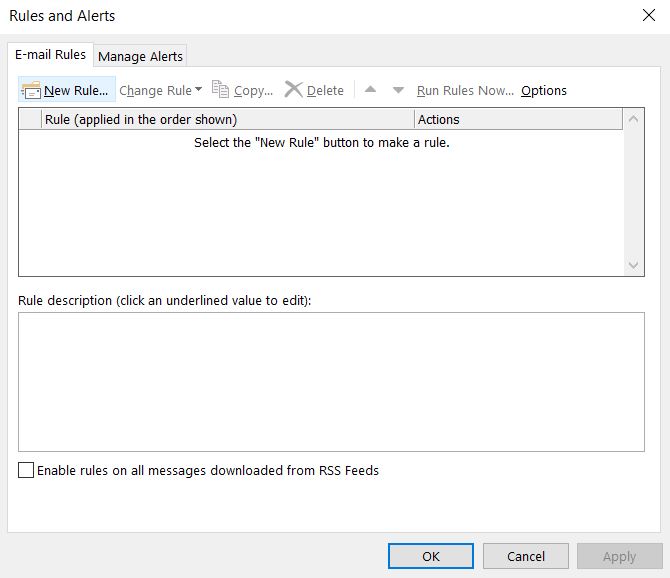
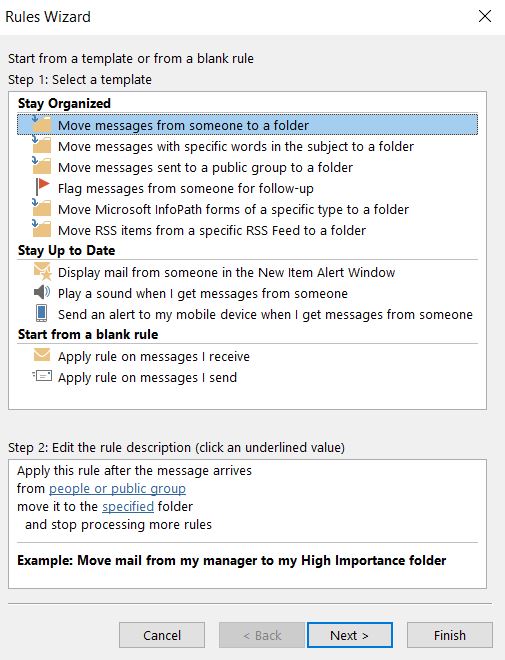
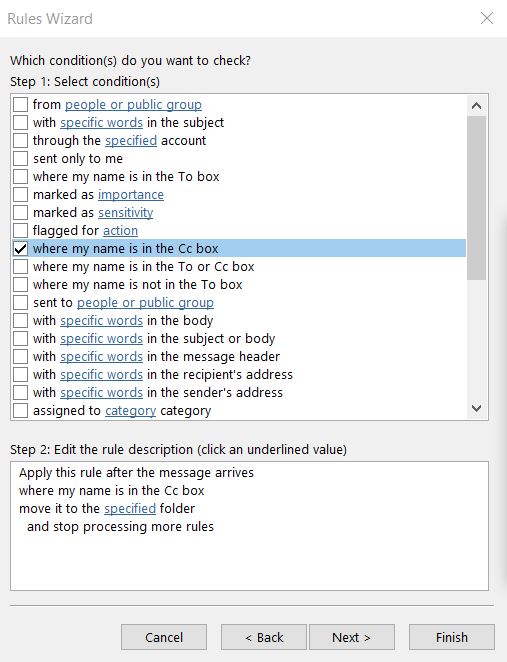


You should then see this window, confirming the if this, then that sequence of what will happen for the rule you’ve set up.
If you see the same as below, click on “Apply” and “OK”
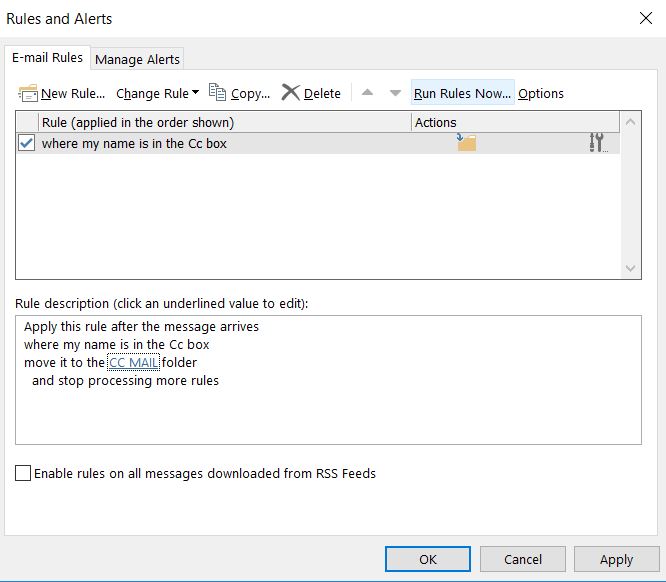
Tip 2: Create a simple filing system
Are you using your email inbox as your de facto to-do list?
If you’re nodding your head, this is the first easy step to freeing yourself from the chains of being a slave to too many emails.
There are 3 basic folders you should set up.
- CC MAIL – which we’ve already covered above. If you’ve not set up an automatic rule yet, go and do it and then come back to this article. You’ll thank me for it!
- NEED TO RESPOND
- NO RESPONSE REQUIRED
That’s it.
I’m not a fan of complex filing systems because half the time, you can never find what you’re looking for.
If you have 50 email folders, chances are that an email’s subject could be filed under more than just one folder. That’s when it gets messy and emails get buried under a confusing filing system.
If you have a team, you’ll probably need another folder called something like “DELEGATED” to flag anything which you’ve forwarded onto one of your direct reports to action.
Otherwise, it really is that simple.
You may want to add a couple more folders over time as you get used to working with your new filing system, but you definitely shouldn’t have more than 10 email folders.
Simplicity is key to dealing with too many emails.
What happens when your filing system becomes an unfathomable monster?
Everything will languish in your inbox, and you’re back to square one. Or just as bad, you’ll spend forever trying to figure out where you’ve filed everything.
Tip 3: Turn off Noises and Notifications
How many times have you stopped your productive workflow whenever you hear the sound notification, see the bell or envelope in your taskbar?
Or, even worse, when the sender and subject line of a new email flashes into the bottom right-hand corner of your screen?
Scientific surveys have confirmed that it takes longer to get back into a rhythm of deep work after something has disturbed us.
If you don’t believe me, check out “The One Thing” by Gary Keller and Jay Papasan or “Deep Work” by Cal Newport.
Ignorance is bliss and silence is golden.
Staying on top of your email doesn’t mean reading it immediately when it arrives in your inbox.
It’s incredibly easy to disable notifications.
In Outlook, go to File – Options – Mail and then ensure that all of these boxes are unchecked.
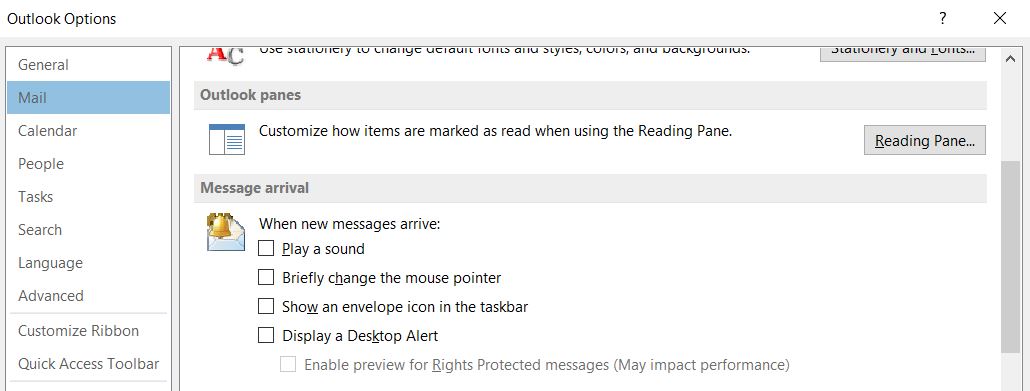
Tip 4: Process email in 2-3 time blocks each day
Dealing with too many emails is way better in longer, single sessions, strategically placed at times which suit your agenda during the working day.
Certain productivity gurus and online influencers claim to only check email once or twice a week.
While that’s great, it’s not a realistic goal for most people who have normal jobs in an office-based environment and who don’t have an assistant to manage their inbox for them.
What to do?
Use time blocks. Set certain times of the day where you’ll dedicate your time and focus to answering your messages and clearing out your inbox.
This way, you stay on top of things and stay disciplined about reaching inbox zero, whilst at the same time not missing anything urgent which requires a fast response.
You’re still able to maintain a productive workday where email is not a constant interruption.
Different things work for different people.
I’m someone who always checks email first thing in the morning. It kind of wakes me up and gets me settled into the working day before tackling something more challenging that requires more concentration and brain power.
Most productivity experts warn against this. Brian Tracy’s “Eat That Frog” method encourages us to tackle challenging or high-impact task first thing in the morning. I personally don’t have the will power when I’ve only been awake for just over an hour.
Email eases me into the working day. However, I then make a point of rarely checking it again before lunch.
Experiment when works best for you. There’s no hard-and-fast rule, except for the next one.
Tip 5: Get to inbox zero at the end of each day
You should not be leaving the office with unfinished business in your inbox.
You’re probably thinking “it’s just a few unread emails” but it’s not.
After a week, 20 unread mails a day becomes 100. After a month, it’s approaching 500.
Darren Hardy’s “The Compound Effect” shows us the magic of compounding results and how small steps over time impact us and allow us to over-achieve and be successful.
Flip this rule on its head, and you can see the negative side of too many emails compounding into an unslayable monster.
It’s time to evict this habit from your messy inbox.
Let’s be clear. Getting to inbox zero at the end of each day doesn’t necessarily mean reading and actioning everything.
What it DOES mean is putting the mails into the appropriate folders based on whether you (or a team member) needs to respond or whether it’s something you can delete or just keep on file for reference.
That’s all it is. Separating the noise from what you actually need to tackle and action yourself.
Try to keep the last half-hour of your working day free of meetings and tackle this before you log off for the evening.
Tip 6: Self-Awareness – How much email are YOU sending?
You’re probably part of the problem. What’s more, you’re quite possibly completely unaware.
Quick exercise:
Go into your sent items and check how many emails you’ve sent over the last 2 weeks in total. This should be a long enough time span to get a representative result.
Divide that by 10 (or however many days you work if you’re part-time). That’s what you’re sending out on average each day.
Now, look at how many you’re receiving.
What’s the send / receive ratio?
If you send on average 100 emails per day and receive 80, you have a send / receive ratio of 1.25. Make a note of yours.
Now, consciously, over the next 2 weeks, only send emails to people if something absolutely must be in writing for audit purposes (see also tips 7 and 8).
After 2 weeks, make a note of how many emails you’ve sent versus how many you’ve received. I can virtually guarantee that the actual numbers will go down. You’ll probably also notice that your send / receive ratio will dip below 1, meaning you received more email than you sent.
That’s OK.
Now that you’ve tackled the part you can control directly, it’s now time to start politely asking your peers to reduce the amount of email they send you, knowing that your own actions are no longer encouraging them to send emails.
Tip 7: Stop copying in everybody, and ask them to do the same too
Anyone aged 40-ish or under, myself included, has almost certainly never worked in an office without email.
Back in the 1980s, ye olde method to communicate involved a typist or a secretary sending typed messages and then distributing them either through the company’s internal post or sending them externally via snail mail.
“CC” actually stands for “carbon copy”.
Typewriters had carbon paper sandwiched between 2 pieces of A4, which copied whatever the person was typing onto the second sheet of paper. It was the only way more than one person could receive the same message before photocopiers, faxes, and then later email became common office accessories.
Now, this was obviously a labour intensive process and carbon copies could typically only be done in duplicate or triplicate. Only those who genuinely needed to receive the message would receive it.
Fast forward to the age of email and at the click of a mouse, we can include as many people as we want in the correspondence.
Ask yourself: Do all these people really need to be informed? Will there be negative consequences if they don’t know what’s going on?
“I wish I was copied in on more emails” said nobody, ever!
It’s trickier to preach this to external recipients, sure, but if you can get on top of internal emails, that’s half the battle.
Tip 8: Eliminate email chains by picking up the phone!
Email volume multiplies when everyone on an email chain chimes in with their 2 cents’ worth.
Festering problems rarely get solved by too many emails, often in long chains. Problems get solved in meetings and on conference calls, when people actually speak to each other, instead of being keyboard warriors.
Email is impersonal and the tone and message can often be misinterpreted. This can lead to people being defensive and ultimately less collaborative.
While conference calls are in most instances not as productive as face-to-face meetings are, the reality is that most communication now is across multiple locations and even time zones.
Speaking is a more effective means of communication to solve a problem than sending an email.
If it’s an instance where it’s easy to get the necessary participants onto a short conference call, my general rule is that a 10 minute phone conversation will prevent half an hour’s worth of time sending and reading emails in a chain.
Chains of emails develop because people feel the need to reply to them.
By someone taking the initiative and saying “no more emails, I’ll set up a quick call,” you can kill the email chain dead in its tracks while assuring those involved that the issue will be discussed and resolved.
So, what do you think? Have you tried any of these?
If you have, which one moved the needle the most for you?
I’d love to hear your comments and suggestions for any other email productivity tips.

